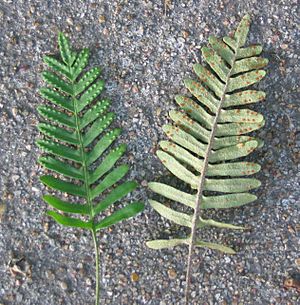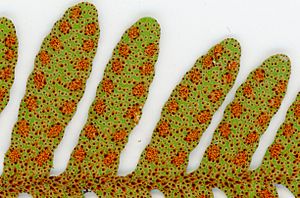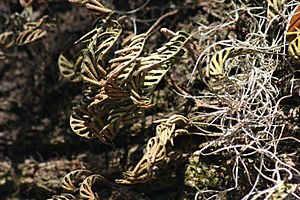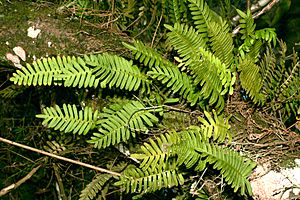Pleopeltis polypodioides facts for kids
Quick facts for kids Pleopeltis polypodioides |
|
|---|---|
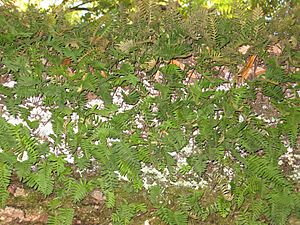 |
|
| Polypodium polypodioides on an oak limb after a brief rain | |
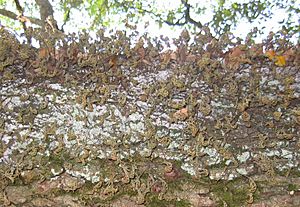 |
|
| Fronds on the same limb in desiccated state | |
| Conservation status | |
| Scientific classification | |
| Synonyms | |
|
Acrosticum polypodioides L. |
The Pleopeltis polypodioides, also known as the resurrection fern, is a special type of fern found in the Americas and Africa. It's called the "resurrection fern" because it can look completely dead and dried up, but then spring back to life when it gets a little water!
Contents
What the Resurrection Fern Looks Like
The leaves, called fronds, of this fern are about 25 cm (10 inches) tall and 5 cm (2 inches) wide. They are green and feel a bit leathery. The fern attaches itself to trees using a thin, creeping stem called a rhizome. This rhizome helps it spread out on its host plant.
Tiny spores, which are like very small seeds, float in the air. When they land on a moist tree branch, they can grow into a new fern. These spores are made in special cases called sporangia found on the fern's leaves. The fern can also grow new plants from its spreading rhizomes.
If you look at the underside of the fern's leaves, you'll see small, round bumps. These are called sori, and they contain the sporangia that hold the spores. These bumps are usually near the edges of the leaves. The spores are produced from summer to fall.
Where the Resurrection Fern Lives
This fern is an epiphyte, which means it's an "air plant." It attaches itself to other plants, like trees, but it doesn't take food from them. Instead, it gets its nutrients and water from the air, rain, and bits of material that collect on the tree's bark.
You can often find the resurrection fern growing on the branches of large trees, especially oaks and cypresses, where it can cover shady areas. It can also grow on rocks and dead logs. Sometimes, you'll see it growing alongside other air plants like Spanish moss.
The P. polypodioides lives in the hardwood forests of the southeastern United States, in states like Alabama, Florida, Georgia, Illinois, Oklahoma, and Texas. It also grows in subtropical parts of America, southern Africa, and other places with humid climates. The farthest known group of these ferns in the US grows on a rock called Leaning Lena in Clear Creek Metro Park in Hocking County, Ohio.
How the Resurrection Fern Survives Drought
The resurrection fern gets its name because it can survive long periods without water. When it's dry, its fronds (leaves) curl up, looking shriveled, gray-brown, and completely dead. But as soon as it gets even a little water, the fern will uncurl and open up, looking like it has "resurrected" or come back to life! Some experts believe these plants could last 100 years without water and still revive.
The roots of the resurrection fern are mainly for holding onto the tree bark. They don't absorb much water. When many ferns grow together in a cluster, the ferns in the middle can stay open longer because they are more protected from drying out. The more humid the air is, the slower the fern's leaves will close.
This fern can lose almost all of its water and still live. Experiments show they can lose up to 97% of their water! Most other plants would die if they lost only 8-12% of their water. When it rains, or even when it gets a tiny bit of moisture, the fern can fully rehydrate and return to normal within 24 to 48 hours. It quickly absorbs water, becoming active again and releasing special compounds that help helpful bacteria grow.
One study found that the resurrection fern might rely on moss for some of its water needs, suggesting they work together.
To survive drying out, resurrection ferns store sugar in their cells. This sugar helps protect the cell parts and keep them stable when there's no water. The fern's cells have a special network that can expand and change shape to absorb a lot of water, sometimes three to four times its own weight!
When the fern first gets water, it flows into the spongy layers of its leaves. Over time, pressure builds up inside the fern's cells, causing the leaves to slowly uncurl. The leaves keep unfolding until they are completely filled with water.
When the fronds dry out, they curl with their bottom sides facing upwards. This helps them rehydrate faster when it rains, because the underside of the leaf blades absorbs most of the water. Special cells in the fern's leaves help direct water to where it's needed for absorption. The ability of the fronds to unroll is because certain cells in the leaves expand a lot when they get water, forcing the fronds to flatten out.
The resurrection fern's cell walls are very flexible. They can change shape when the fern dries out and then return to their original shape when it gets water, without breaking. This is helped by special proteins called dehydrins, which are only made when the fern is drying or already dry.
Scientists have also studied how much heat the resurrection fern can handle before its cells get damaged. They found that this fern can tolerate very high temperatures (around 50 degrees Celsius or 122 degrees Fahrenheit) before showing signs of stress. This suggests that the fern's cells have a way to store energy and survive extreme heat and dryness.
Reproduction
The fern reproduces using sori, which are clusters of spore cases found on the bottom of its fronds. The fern releases these spores in the summer and early fall. New ferns can also grow from pieces of its rhizome if they root in a new spot.
See also
 In Spanish: Pleopeltis polypodioides para niños
In Spanish: Pleopeltis polypodioides para niños



